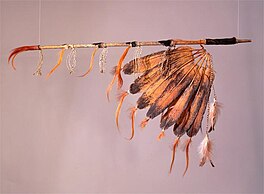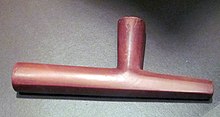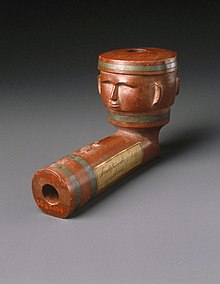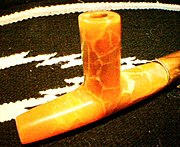cap; indigenous is an adjective, and not part of a proper noun, in this usage |
Paine Ellsworth (talk | contribs) m →Ceremonial use: clarify |
||
| (3 intermediate revisions by the same user not shown) | |||
| Line 1: | Line 1: | ||
[[Image:Peace pipe.jpg|thumb|264px|right|A [[Lakota people|Lakota]] (Sioux) ''[[chanunpa]]'' pipestem, without the pipe bowl, displayed at the [[United States]] [[Library of Congress]]]] |
[[Image:Peace pipe.jpg|thumb|264px|right|A [[Lakota people|Lakota]] (Sioux) ''[[chanunpa]]'' pipestem, without the pipe bowl, displayed at the [[United States]] [[Library of Congress]]]] |
||
'''Calumet''' (kal-yə-ˌmet, -mət) is a [[Norman language|Norman]] word for a ceremonial [[smoking pipe (tobacco)|smoking pipe]] used by some [[indigenous peoples of the Americas|indigenous American]] nations. Traditionally it has been smoked to seal a [[Covenant (historical)|covenant]] or [[treaty]], or to offer prayers in a religious ceremony. |
|||
== Etymology == |
== Etymology == |
||
| ⚫ | ''Calumet'' is a [[Norman language|Norman]] word ({{IPA-fr|kalyme|pron}}), first recorded in [[David Ferrand]]'s ''La Muse normande'' around 1625–1655.<ref>[http://www.cnrtl.fr/etymologie/calumet CNRTL site etymology of calumet]</ref> Its first meaning was "sort of reeds used to make pipes", with a suffix substitution for ''calumel''.<ref>The word comes from Late Latin ''calamellus''. The Northern Norman dialect retains the group /ca/, when it turns into /ʃa/ (''cha-'') in Common French and it retains the suffix ''-el'', when it has turned into ''-eau'' in Common French. The fall of the final /l/ is specific for the [[Cauchois dialect]], which explains the later confusion with another suffix ''-et'', pronounced the same way [e].</ref> It corresponds to the French word ''chalumeau'', meaning 'reed' (Modern French also means 'straw', 'blowlamp').<ref>CNRTL</ref><ref>T.F. Hoad, ''English Etymology'', Oxford University Press, 1993, p. 59</ref> The term was used by Norman-French settlers in [[Canada (New France)|Canada]] to describe the ceremonial pipes they saw used among the [[First Nations]] people of the region.<ref name=Rowland>Rowland, Dunbar (1907)</ref> |
||
The [[First Nations]] and [[indigenous peoples of the Americas]] who use ceremonial pipes almost always refer to those pipes by their names in that culture's indigenous language. There is no agreement on what to call all ceremonial pipes across the hundreds of diverse Native cultures. |
|||
| ⚫ | ''Calumet'' is a [[Norman language|Norman]] word ({{IPA-fr|kalyme|pron}}), first recorded in David Ferrand's ''La Muse normande'' around 1625–1655 |
||
==Overview== |
==Overview== |
||
[[Image:Black hawk calumet.jpg|thumb|Calumet used by [[Black Hawk (chief)|Black Hawk]], on display at [[Black Hawk State Historic Site]].]] |
[[Image:Black hawk calumet.jpg|thumb|Calumet used by [[Black Hawk (chief)|Black Hawk]], on display at [[Black Hawk State Historic Site]].]] |
||
A common material for calumet pipe bowls is red pipestone or [[catlinite]],<ref name = Ioway>{{Cite web | title = Catlinite, Calumet Pipes and Pipestone National Monument | work = Maps, Material, Culture, and Memory: On the Trail of the Ioway | publisher = [[University of Iowa]] | url = http://www.uiowa.edu/~osa/IAM/2007Ioway/catlinite.htm | accessdate = 19 May 2012}}</ref> a fine-grained easily worked stone of a rich red color of the [[Coteau des Prairies]], west of the [[Big Stone Lake]] in [[South Dakota]]. The [[Pipestone National Monument|pipestone quarries]] have traditionally been neutral ground among warring tribes, as people from multiple nations journeyed to the quarry to obtain the sacred pipestone.<ref name = pipestibe>{{Cite web | title = Pipestone National Monument | publisher = [[National Park Service]] | url = http://www.nps.gov/pipe/index.htm | accessdate = 19 May 2012 }}</ref> |
|||
Tobacco, ''Nicotiana rustica'',<ref>[http://www.barefootsworld.net/chanunpa.html The Native American Chanunpa, the Sacred Pipe]<!-- Bot generated title -->, Barefoot's World</ref> was originally used primarily by eastern tribes but western tribes often mixed it with other herbs, barks, and plant matter,<ref>Charles L. Cutler. ''Tracks that speak: the legacy of Native American words in North American culture''. Houghton Mifflin Harcourt (Boston : 2002).</ref> in a preparation commonly known as ''[[Kinnikinnick]]''. |
Tobacco, ''Nicotiana rustica'',<ref>[http://www.barefootsworld.net/chanunpa.html The Native American Chanunpa, the Sacred Pipe]<!-- Bot generated title -->, Barefoot's World</ref> was originally used primarily by eastern tribes but western tribes often mixed it with other herbs, barks, and plant matter, <ref>Charles L. Cutler. ''Tracks that speak: the legacy of Native American words in North American culture''. Houghton Mifflin Harcourt (Boston : 2002).</ref> in a preparation commonly known as ''[[Kinnikinnick]]''. |
||
Some northern Sioux people used long, stemmed pipes for ceremonies. Other peoples, such as the [[Catawba people|Catawba]] in the American Southeast, used ceremonial pipes formed as round, footed bowls. A tubular smoke tip projected from each of the four cardinal directions on the bowl. |
|||
{{-}} |
{{-}} |
||
==Ceremonial use== |
==Ceremonial use== |
||
{{See also|Peace Pipe (disambiguation)}} |
|||
[[File:Harry Behn peacepipe.png|thumb|264px|left|[[Harry Behn]] smoking a pipe with members of the [[Blackfoot]] nation]] |
[[File:Harry Behn peacepipe.png|thumb|264px|left|[[Harry Behn]] smoking a pipe with members of the [[Blackfoot]] nation]] |
||
Native American ceremonial pipes have sometimes been |
Calumets and other Native American ceremonial pipes have sometimes been identified as "peace pipes", a European/English-language construct based on one type of pipe and one way it was used. Various types of ceremonial pipes have been used by numerous [[Native Americans in the United States|Native American]] cultures. The style of pipe, materials smoked, and ceremonies are unique to the specific and distinct religions of those nations. Calumets were used to mark war and peace, as well as commerce and trade, and social and political decision-making.<ref name=autogenerated1>{{cite book|last=Moore|first=Powell A.|title=The Calumet Region: Indiana's Last Frontier|year=1959|publisher=Indiana Historical Bureau}}</ref> |
||
During his travels down the [[Mississippi River]] in 1673, Father [[Jacques Marquette]] documented the universal respect that the ceremonial "peace pipe" was shown among all |
During his travels down the [[Mississippi River]] in 1673, Father [[Jacques Marquette]] documented the universal respect that the ceremonial "peace pipe" was shown among all native peoples he encountered, even those at war with each other. He claimed that presenting the pipe during battle would halt the fighting. The [[Illinois tribe|Illinois]] people gave Marquette such a pipe as a gift to ensure his safe travel through the interior of the land.<ref name=autogenerated1 /> |
||
Father [[Pierre-Jean De Smet]] gives an account of the |
Father [[Pierre-Jean De Smet]] gives an account of the calumet ceremony done by the [[Cheyenne people]]: "First they give the [[Great Spirit]] to smoke, holding the pipe toward the heavens, then toward the sun, the earth and the water, the calumet goes the rounds of the lodge three times; it passes from hand to hand, and every one takes half a dozen puffs." <ref>Life, letters and travels of Father Pierre-Jean de Smet, S.J. 1801-1873: missionary labors and adventures among the wild tribes of the North American Indians Vol 1</ref> |
||
In ceremonial usage, the smoke is believed to carry prayers to the attention of the [[Creator deity|Creator]] or other powerful spirits. [[Lakota people|Lakota]] tradition tells that [[White Buffalo Calf Woman]] brought the ''[[Chanunpa]]'' to the people, and instructed them in its symbolism and ceremonies. |
In ceremonial usage, the smoke is believed to carry prayers to the attention of the [[Creator deity|Creator]] or other powerful spirits. [[Lakota people|Lakota]] tradition tells that [[White Buffalo Calf Woman]] brought the ''[[Chanunpa]]'' to the people, and instructed them in its symbolism and ceremonies. |
||
| Line 35: | Line 34: | ||
[[Image:UtePipe3.jpg|right|thumb|180px|Uncompahgre Ute Salmon alabaster ceremonial pipe. Ute pipe styles are similar to those of the [[Plains Indians]], with notable differences. Ute pipes are thicker and use shorter pipestems than the plains style and more closely resemble the pipe styles of their Northern neighbors, the [[Shoshone]].]] |
[[Image:UtePipe3.jpg|right|thumb|180px|Uncompahgre Ute Salmon alabaster ceremonial pipe. Ute pipe styles are similar to those of the [[Plains Indians]], with notable differences. Ute pipes are thicker and use shorter pipestems than the plains style and more closely resemble the pipe styles of their Northern neighbors, the [[Shoshone]].]] |
||
Several Native tribes make ceremonial pipes. The types of stones used vary by tribe and locality. Some of the known types of pipe stone and pipe materials are: |
|||
'''Clay''' – The [[Cherokee]] and [[Chickasaw]] both fashion pipes made from fired [[clay]] |
'''Clay''' – The [[Cherokee]] and [[Chickasaw]] both fashion pipes made from fired [[clay]]; they use small [[Phragmites|reed]] cane pipestems made from river cane. These pipes are made from aged river clay hardened in a hot fire. |
||
'''Red pipestone''' – [[Catlinite]] is an iron-rich, reddish, soft [[argillite]] or [[claystone]] typically excavated from beds occurring between hard [[Sioux Quartzite]] layers<ref>[http://www.nps.gov/pipe/learn/nature/geologicformations.htm Geologic Formations, Pipestone National Monument, Minnesota, National Park Service] </ref> below groundwater level, as the stone erodes rapidly when exposed to the weather and outside air. Red pipestone is used primarily by the [[Plains Indians|Plains Tribes]], and the Western and [[Great Basin Tribes]]. The stone can be found in [[Tennessee]] |
'''Red pipestone''' – [[Catlinite]] is an iron-rich, reddish, soft [[argillite]] or [[claystone]] typically excavated from beds occurring between hard [[Sioux Quartzite]] layers<ref>[http://www.nps.gov/pipe/learn/nature/geologicformations.htm Geologic Formations, Pipestone National Monument, Minnesota, National Park Service] </ref> below groundwater level, as the stone erodes rapidly when exposed to the weather and outside air. Red pipestone is used primarily by the [[Plains Indians|Plains Tribes]], and the Western and [[Great Basin Tribes]]. The stone can be found in [[Tennessee]] (South Central), Minnesota (Pipestone), and [[Utah]] (Delta, Uinta). Sacred pipestone comes from [[Pipestone, Minnesota]]. The quarry is located just north of the town at the [[Pipestone National Monument]]. Today only Native Americans are allowed to quarry the pipestone from this quarry. The pipestone or catlinite from this quarry is softer than any other catlinite. |
||
[[Image:MissPipe1.jpg|left|thumb|180px|Mississippian and Eastern Woodlands style "acorn" pipe. These pipes have been found in [[Mississippian culture]] earthwork mounds in the Eastern United States. This acorn pipe is made from South Dakota red pipestone.]] |
[[Image:MissPipe1.jpg|left|thumb|180px|Mississippian and Eastern Woodlands style "acorn" pipe. These pipes have been found in [[Mississippian culture]] earthwork mounds in the Eastern United States. This acorn pipe is made from South Dakota red pipestone.]] |
||
'''Blue pipestone''' – Also a form of catlinite, |
'''Blue pipestone''' – Also a form of catlinite, blue pipestone is used almost predominantly by the Plains Tribes for ceremonial pipes. Deposits of the stone are found in South Dakota. The use of blue pipestone began about the same time as the adoption of the [[horse]] among the Plains Tribes. |
||
'''Bluestone''' – a hard, greenish-blue quartzite stone from the southern [[Appalachian Mountains]]. After being worked, it takes on a decidedly greenish cast. This stone has been used by several Eastern Woodlands tribes for pipemaking. Cherokee, [[Creek people|Creek]], and Chickasaw make pipes from bluestone. |
'''Bluestone''' – a hard, greenish-blue quartzite stone from the southern [[Appalachian Mountains]]. After being worked, it takes on a decidedly greenish cast. This stone has been used by several Eastern Woodlands tribes for pipemaking. Cherokee, [[Creek people|Creek]], and Chickasaw make pipes from bluestone. Several ancient Mississippian culture bluestone pipes have been excavated. |
||
| ⚫ | |||
'''Salmon alabaster''' – the [[Ute people|Uncompahgre]] [[Ute Tribe|Ute]] make ceremonial pipes from salmon [[alabaster]] mined in central [[Colorado]]. |
'''Salmon alabaster''' – the [[Ute people|Uncompahgre]] [[Ute Tribe|Ute]] make ceremonial pipes from salmon [[alabaster]] mined in central [[Colorado]]. |
||
| ⚫ | |||
'''Green pipestone''' – A white on green marbled [[cupric]] pipestone found in [[Wyoming]] and South Dakota is used by the [[Shoshone]], Ute, and Plains Tribes for personal and ceremonial pipes. This stone is also used to carve sacred effigies and religious items. |
'''Green pipestone''' – A white on green marbled [[cupric]] pipestone found in [[Wyoming]] and South Dakota is used by the [[Shoshone]], Ute, and Plains Tribes for personal and ceremonial pipes. This stone is also used to carve sacred effigies and religious items. |
||
'''Black pipestone (South Dakota)''' – a soft, brittle, white on black marbled pipestone found in South Dakota and used by some of the Plains Tribes for |
'''Black pipestone (South Dakota)''' – a soft, brittle, white on black marbled pipestone found in South Dakota and used by some of the Plains Tribes for ceremonial pipes. |
||
'''Black pipestone (Uinta)''' – an extremely hard black quartzite slate which has undergone [[metamorphic rock|metamorphic]] compression and is found in the southeastern drainage of the [[Uinta Mountains]] in Utah and Colorado. This stone has been used by the Great Basin Tribes for war [[club (weapon)|club]]s and pipes that are jet black with a high gloss when polished. Stones which have tumbled down creeks and drainages are always selected, since these stones typically contained no cracks or defects. |
'''Black pipestone (Uinta)''' – an extremely hard black quartzite slate which has undergone [[metamorphic rock|metamorphic]] compression and is found in the southeastern drainage of the [[Uinta Mountains]] in Utah and Colorado. This stone has been used by the Great Basin Tribes for war [[club (weapon)|club]]s and pipes that are jet black with a high gloss when polished. Stones which have tumbled down creeks and drainages are always selected, since these stones typically contained no cracks or defects. |
||
| Line 58: | Line 57: | ||
[[Image:Pipestone1.jpg|right|thumb|180px|Both raw and cut-and-slabbed high grade red pipestone from [[Delta, Utah]].]] |
[[Image:Pipestone1.jpg|right|thumb|180px|Both raw and cut-and-slabbed high grade red pipestone from [[Delta, Utah]].]] |
||
Historically, Native Americans who |
Historically, Native Americans who used the [[bow and arrow]] also used [[bow drill]]s made with hard white [[quartz]] points. When combined with water, these could bore out even the hardest of pipestones.{{citation needed|date=November 2012}} |
||
Early Native Americans used moistened [[rawhide (textile)|rawhide]] strips rolled in crushed white quartz and stretched with a bow handle to shape and rough the pipes. |
Early Native Americans used moistened [[rawhide (textile)|rawhide]] strips rolled in crushed white quartz and stretched with a bow handle to shape and rough the pipes. The efficiency of such bow stone saws in cutting and slabbing a large piece of red pipestone is surprising given their apparent simplicity.{{citation needed|date=November 2012}} Pipes were also shaped and roughed with hard [[sandstone]]s, afterward polished with water, then sanded with progressively finer and finer [[abrasive]] grit and animal hide, finally being rubbed with [[fat]] or [[sebum|facial oils]] to complete polishing.{{citation needed|date=November 2012}} |
||
==See also== |
==See also== |
||
Revision as of 11:29, 19 August 2015

Calumet (kal-yə-ˌmet, -mət) is a Norman word for a ceremonial smoking pipe used by some indigenous American nations. Traditionally it has been smoked to seal a covenant or treaty, or to offer prayers in a religious ceremony.
Etymology
Calumet is a Norman word (pronounced [kalyme]), first recorded in David Ferrand's La Muse normande around 1625–1655.[1] Its first meaning was "sort of reeds used to make pipes", with a suffix substitution for calumel.[2] It corresponds to the French word chalumeau, meaning 'reed' (Modern French also means 'straw', 'blowlamp').[3][4] The term was used by Norman-French settlers in Canada to describe the ceremonial pipes they saw used among the First Nations people of the region.[5]
Overview

A common material for calumet pipe bowls is red pipestone or catlinite,[6] a fine-grained easily worked stone of a rich red color of the Coteau des Prairies, west of the Big Stone Lake in South Dakota. The pipestone quarries have traditionally been neutral ground among warring tribes, as people from multiple nations journeyed to the quarry to obtain the sacred pipestone.[7]
Tobacco, Nicotiana rustica,[8] was originally used primarily by eastern tribes but western tribes often mixed it with other herbs, barks, and plant matter, [9] in a preparation commonly known as Kinnikinnick.
Some northern Sioux people used long, stemmed pipes for ceremonies. Other peoples, such as the Catawba in the American Southeast, used ceremonial pipes formed as round, footed bowls. A tubular smoke tip projected from each of the four cardinal directions on the bowl.
Ceremonial use

Calumets and other Native American ceremonial pipes have sometimes been identified as "peace pipes", a European/English-language construct based on one type of pipe and one way it was used. Various types of ceremonial pipes have been used by numerous Native American cultures. The style of pipe, materials smoked, and ceremonies are unique to the specific and distinct religions of those nations. Calumets were used to mark war and peace, as well as commerce and trade, and social and political decision-making.[10]
During his travels down the Mississippi River in 1673, Father Jacques Marquette documented the universal respect that the ceremonial "peace pipe" was shown among all native peoples he encountered, even those at war with each other. He claimed that presenting the pipe during battle would halt the fighting. The Illinois people gave Marquette such a pipe as a gift to ensure his safe travel through the interior of the land.[10]
Father Pierre-Jean De Smet gives an account of the calumet ceremony done by the Cheyenne people: "First they give the Great Spirit to smoke, holding the pipe toward the heavens, then toward the sun, the earth and the water, the calumet goes the rounds of the lodge three times; it passes from hand to hand, and every one takes half a dozen puffs." [11]
In ceremonial usage, the smoke is believed to carry prayers to the attention of the Creator or other powerful spirits. Lakota tradition tells that White Buffalo Calf Woman brought the Chanunpa to the people, and instructed them in its symbolism and ceremonies.
According to oral traditions, and as demonstrated by pre-contact pipes held in museums and tribal and private holdings, some ceremonial pipes are adorned with feathers, fur, human or animal hair, beadwork, quills, carvings or other items having significance for the owner. Other pipes are very simple. Many are not kept by an individual, but are instead held collectively by a medicine society or similar indigenous ceremonial organization.
Pipestone varieties


Several Native tribes make ceremonial pipes. The types of stones used vary by tribe and locality. Some of the known types of pipe stone and pipe materials are:
Clay – The Cherokee and Chickasaw both fashion pipes made from fired clay; they use small reed cane pipestems made from river cane. These pipes are made from aged river clay hardened in a hot fire.
Red pipestone – Catlinite is an iron-rich, reddish, soft argillite or claystone typically excavated from beds occurring between hard Sioux Quartzite layers[12] below groundwater level, as the stone erodes rapidly when exposed to the weather and outside air. Red pipestone is used primarily by the Plains Tribes, and the Western and Great Basin Tribes. The stone can be found in Tennessee (South Central), Minnesota (Pipestone), and Utah (Delta, Uinta). Sacred pipestone comes from Pipestone, Minnesota. The quarry is located just north of the town at the Pipestone National Monument. Today only Native Americans are allowed to quarry the pipestone from this quarry. The pipestone or catlinite from this quarry is softer than any other catlinite.

Blue pipestone – Also a form of catlinite, blue pipestone is used almost predominantly by the Plains Tribes for ceremonial pipes. Deposits of the stone are found in South Dakota. The use of blue pipestone began about the same time as the adoption of the horse among the Plains Tribes.
Bluestone – a hard, greenish-blue quartzite stone from the southern Appalachian Mountains. After being worked, it takes on a decidedly greenish cast. This stone has been used by several Eastern Woodlands tribes for pipemaking. Cherokee, Creek, and Chickasaw make pipes from bluestone. Several ancient Mississippian culture bluestone pipes have been excavated.
Salmon alabaster – the Uncompahgre Ute make ceremonial pipes from salmon alabaster mined in central Colorado.

Green pipestone – A white on green marbled cupric pipestone found in Wyoming and South Dakota is used by the Shoshone, Ute, and Plains Tribes for personal and ceremonial pipes. This stone is also used to carve sacred effigies and religious items.
Black pipestone (South Dakota) – a soft, brittle, white on black marbled pipestone found in South Dakota and used by some of the Plains Tribes for ceremonial pipes.
Black pipestone (Uinta) – an extremely hard black quartzite slate which has undergone metamorphic compression and is found in the southeastern drainage of the Uinta Mountains in Utah and Colorado. This stone has been used by the Great Basin Tribes for war clubs and pipes that are jet black with a high gloss when polished. Stones which have tumbled down creeks and drainages are always selected, since these stones typically contained no cracks or defects.
Traditional pipemaking tools

Historically, Native Americans who used the bow and arrow also used bow drills made with hard white quartz points. When combined with water, these could bore out even the hardest of pipestones.[citation needed]
Early Native Americans used moistened rawhide strips rolled in crushed white quartz and stretched with a bow handle to shape and rough the pipes. The efficiency of such bow stone saws in cutting and slabbing a large piece of red pipestone is surprising given their apparent simplicity.[citation needed] Pipes were also shaped and roughed with hard sandstones, afterward polished with water, then sanded with progressively finer and finer abrasive grit and animal hide, finally being rubbed with fat or facial oils to complete polishing.[citation needed]
See also
Notes
- ^ CNRTL site etymology of calumet
- ^ The word comes from Late Latin calamellus. The Northern Norman dialect retains the group /ca/, when it turns into /ʃa/ (cha-) in Common French and it retains the suffix -el, when it has turned into -eau in Common French. The fall of the final /l/ is specific for the Cauchois dialect, which explains the later confusion with another suffix -et, pronounced the same way [e].
- ^ CNRTL
- ^ T.F. Hoad, English Etymology, Oxford University Press, 1993, p. 59
- ^ Rowland, Dunbar (1907)
- ^ "Catlinite, Calumet Pipes and Pipestone National Monument". Maps, Material, Culture, and Memory: On the Trail of the Ioway. University of Iowa. Retrieved 19 May 2012.
- ^ "Pipestone National Monument". National Park Service. Retrieved 19 May 2012.
- ^ The Native American Chanunpa, the Sacred Pipe, Barefoot's World
- ^ Charles L. Cutler. Tracks that speak: the legacy of Native American words in North American culture. Houghton Mifflin Harcourt (Boston : 2002).
- ^ a b Moore, Powell A. (1959). The Calumet Region: Indiana's Last Frontier. Indiana Historical Bureau.
- ^ Life, letters and travels of Father Pierre-Jean de Smet, S.J. 1801-1873: missionary labors and adventures among the wild tribes of the North American Indians Vol 1
- ^ Geologic Formations, Pipestone National Monument, Minnesota, National Park Service
References
- This article incorporates text from a publication now in the public domain: Chisholm, Hugh, ed. (1911). "Calumet". Encyclopædia Britannica (11th ed.). Cambridge University Press.
- Charles L. Cutler. Tracks that speak: the legacy of Native American words in North American culture. Houghton Mifflin Harcourt (Boston : 2002)
External links
- Pipestone County Museum – History
- Symbol and Substance in American Indian Art, an exhibition catalog from The Metropolitan Museum of Art (fully available online as PDF), which contains material on calumets
